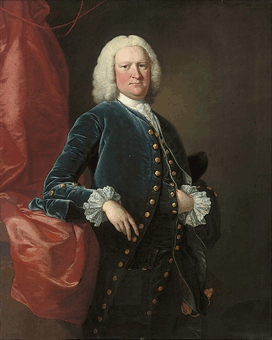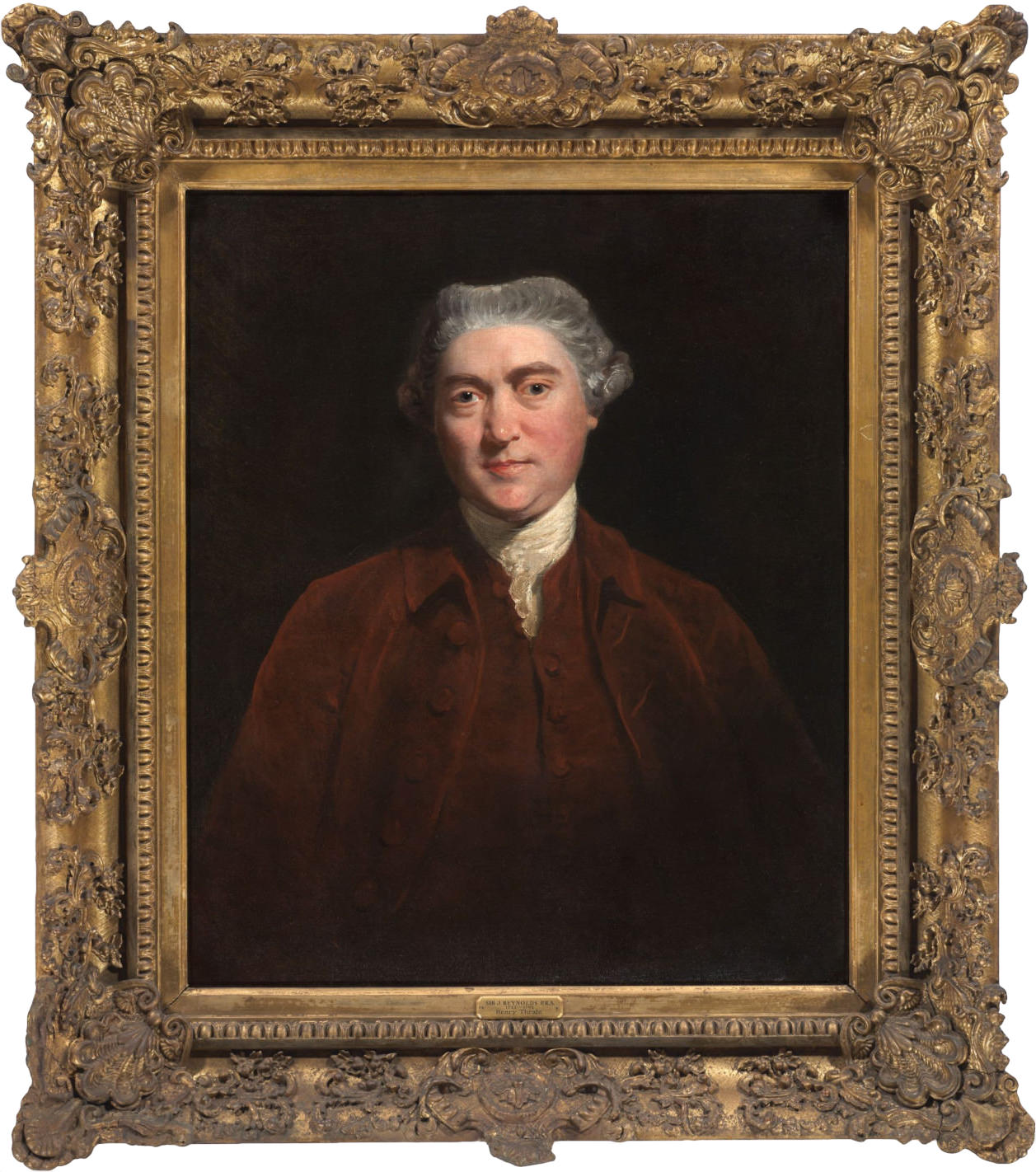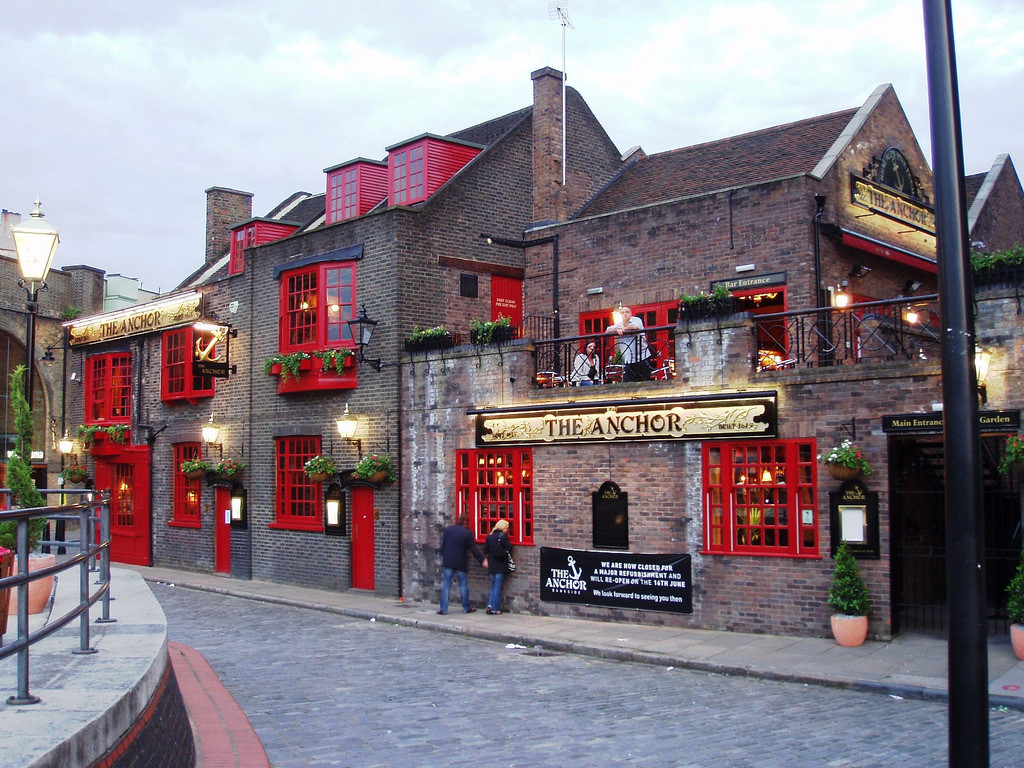The Anchor
The Castle
At the junction of Bankside and Park Street (formerly known as Bank End) there stood in the 15th and 16th centuries an inn called the Castell upon the Hope with a wharf, houses and four cottages - so called because of its turreted walls.
In 1479 they were in the possession of John Eierby, citizen and fishmonger of London, who died in 1500 leaving them to his wife, Elizabeth, with the proviso that after her death they were to be sold and the proceeds devoted to:
deedes of almes and werkes of charity.
The Castle was one of the Stewhouses of Bankside. Of the Southwark 'Stewhouses' - more commonly known to us as a brothel - John Stow said…
Stew-houses had signs on their fronts, towards the Thames, not hanged out, but painted on the walls. Running a 'stew' was no casual affair; as early as 1162 an Act of Parliament required:
- No stew-holder or his wife should let or stay any single woman, to go and come freely at all times when they listed.
- No stew-holder to keep any woman to board, but she to board abroad at her pleasure.
- To take no more for the woman's chamber in the week than fourteen pence1.
- Not to keep open his doors upon the holidays.
- Not to keep any single woman in his house on the holidays, but the bailiff to see them voided out of the lordship.
- No single woman to be kept against her will that would leave her sin.
- No stew-holder to receive any woman of religion, or any man's wife.
- No single woman to take money to lie with any man, but she lie with him all night till the morrow.
- No man to be drawn or enticed into any stew-house.
- The constables, bailiff, and others, every week to search every stew-house.
- No stew-holder to keep any woman that hath the perilous infirmity of burning, not to sell bread, ale flesh, fish, wood coal, or any victuals, etc.'
Anyone caught flaunting these rules was severely dealt with by 'great pain and punishment'.
In 1506 John Sandes, the occupier, was presented by the constables at the Court Leet of the Bishop of Winchester for keeping his house open on feast days and for allowing women to board there contrary to the regulations.2
In 1559 Alexander Amcottes sold to Vincent Amcottes, citizen and fishmonger of London, his messuage called "the Castell on the hoope" with a wharf and houses and four cottages adjoining on the east and "Cellers, Sollers, Gardeyns, Pondes, hedges and dyches" abutting on the land formerly of William Owghtred, knight, "late apperteynyng to the Churche of Saynt margarettes" on the south and:
extendeth in length from the kynges highewaye of olde tyme called the millwaye towardes the Easte unto the landes … sometyme of Sir Myles of Stapylton and Thomas Paterling and late belongyng to the churche of Saynte Margarettes … towardes the Weste.2
This is the little alehouse on Bankside where on 2 September 1666 Samuel Pepys:
staid till it was dark and saw the fire3 grow.
Southern portion
Vincent Amcottes divided the property. The southern portion he sold in 1580 to Richard Spier. In the 17th century it was the subject of many lawsuits but in 1707 it was in the possession of Spier's great grandson who stated that two messuages and a dyehouse had been built thereon. It was bought by Ralph Thrale in 1739 and subsequently a watchhouse was built on part of it and the rest was used to widen Park Street.2
Northern portion
The northern portion was sold by Vincent Amcottes in 1562 to John Cheyne whose son and heir, Henry, on 30 January 1582/3, transferred it to John Drew under the description of:
all those two messuages … called the gonne and the castle with twoe gardeins thereunto adjoyninge and all those twoe tenementes on theast side next adjoynynge to … the Castell and all the gardein plattes and voyd groundes on the backsides of the same … and … all the wharfe which is betwene the foresaid messuages … and the River … and … the stayers and landinge place … sometyme in the tenure … of John Smythe carpenter … and all those three messuages … with gardens … sometyme in the severall tenures of William Clement Taillor, John Roo Chaundeler and Peter Hardinge, Blacksmythe.2
The last three houses had then been divided into six. John Drew died in 1595. By his will he left 40 shillings to his tenants on Bankside to "make merry withall".2
His son John, who inherited the property, then known as Drew's Rents, got himself heavily in debt and had to sell his inheritance to James James, apothecary, to whom his son, another John, was apprenticed. There were then fourteen tenements in the rents.2
Another fire devastated the pub and it was rebuilt in 1676.
James James died in 1689 and the property was sold by his legatee, James Coysh, to Walter Gibbons who in 1725 sold it to Edmund Halsey.
In 1764 Henry Thrale, who had obtained a lease of the premises from Halsey's executors, bought the freehold. Among the records of Barclay Perkins and Co., Ltd., is a note made just prior to this purchase stating that Mr. Edward Dodson had lived at the alehouse at the corner called the sign of the Castle for the previous seven or eight years.2
The Anchor
By the time Henry Thrale, purchased the property in 1764, a great many buildings had sprung up in the vicinity and the premises were in a tumbledown state and was pulled down.
In 1770 Henry let the on a building lease to William Allen on the condition that he put it to sober use and erect substantial houses or similar buildings on the site. Allen undertook to spend £1,000 within the next five years in building "good and substantial" messuages or warehouses on the site. Thus inn had been transformed from a place of ill repute to a plain and simple ale house.
The 18th century building included a minstrels' gallery, old oak beams and cubby holes to hide fugitives from nearby Clink Prison.2
The current Anchor building at 34 Park Street, London SE1 9EF was therefore erected in 1770–75 by William Allen for Henry Thrale, though the first mention of it by its present name which has been found is in a list of recognisances for 1822. It became the “brewery tap” for Thrale’s and then Barclay Perkins Brewery.
On the death of Henry Thrale on 4 April 1781 the Anchor Brewery and associated buildings, of which The Castle site was part, were sold by auction to David Barclay and his partner John Perkins for £135,000. By 1787, Joseph Bickerton was the tenant of the dwelling house, warehouses, stables and wharf.2
Contemporary developments
In June 2008, the Anchor recently underwent one of the most costly refurbishments in pub history, at a reported 2.6 million pounds sterling funded by the current owners Punch Taverns.2
 |
Henry Thrale M.P. 1724/9 - 2 May 1821 |
|---|---|
| Henry Thrale | Family tree and portraits · Homes · H. Thrale & Co. brewery · Parliamentary career · Pets · Travels · Coaching accident · Ill health · Death · Mourning tablet · Burial vault · Will · Testimonials |
| Hester Salusbury | Courtship · Marriage dowry · Marriage · Children · 13th anniversary |
| People | Father: Ralph Thrale M.P. · Arthur Murphy · Samuel Johnson · Jeremiah Crutchley · Sir John Lade · Streatham Worthies · King Louis XVI & Queen Marie Antoinette |
| Writings about | Dr Johnson's 'Own Dear Master · The Thrales of Streatham Park · Three Centuries · Thraliana |
| Signature |  |
 |
Hester Lynch Thrale née Salusbury 1741 - 2 May 1821 |
|---|---|
| Hester Thrale | Family tree and portraits · Homes · Works · Writings . Thraliana · Pets · Travels · 80th party · Criticism · Death · Obituaries |
| Henry Thrale | Courtship · Marriage dowry · Marriage · Children · 13th anniversary |
| Gabriel Piozzi | Marriage · 7th anniversary · Adopted son · Miscarried daughter |
| People | Samuel Johnson · Streatham Worthies · Proposal from Mr. Swale · King Louis XVI & Queen Marie Antoinette |
| Writings about | The Thrales of Streatham Park · Dr Johnsons Women · Intimate letters · Hester Lynch Piozzi · Dr Johnsons Women · Doctor Johnson's Mrs Thrale · By Samuel Johnson: Ode to · 35th verses · By Herbert Lawrence: Song to Hester |
| Signature |  |




